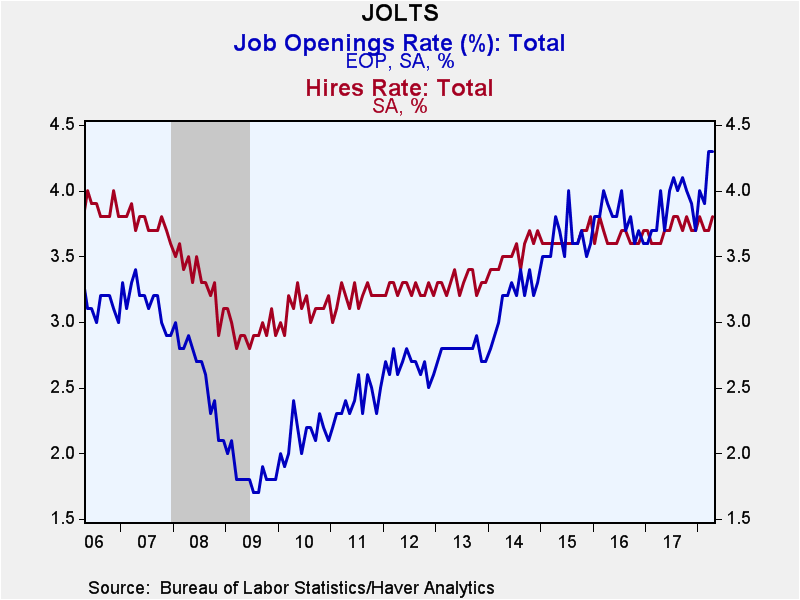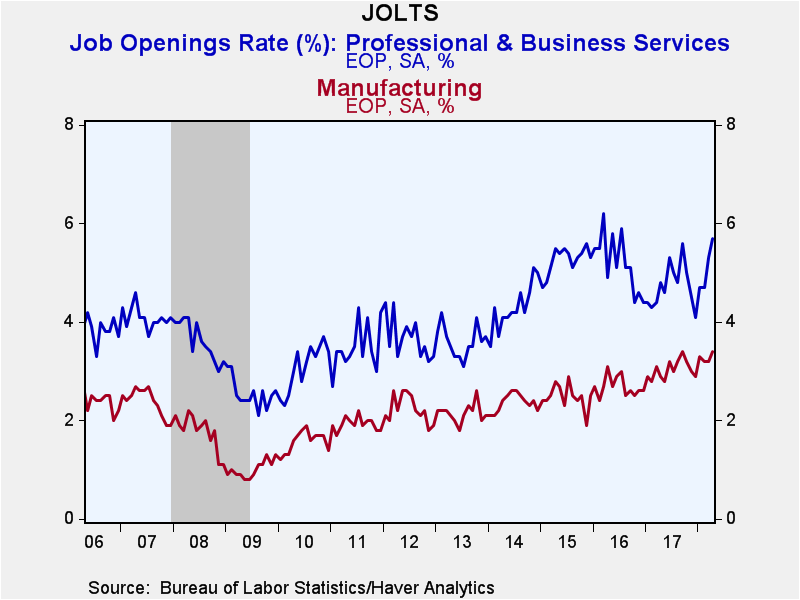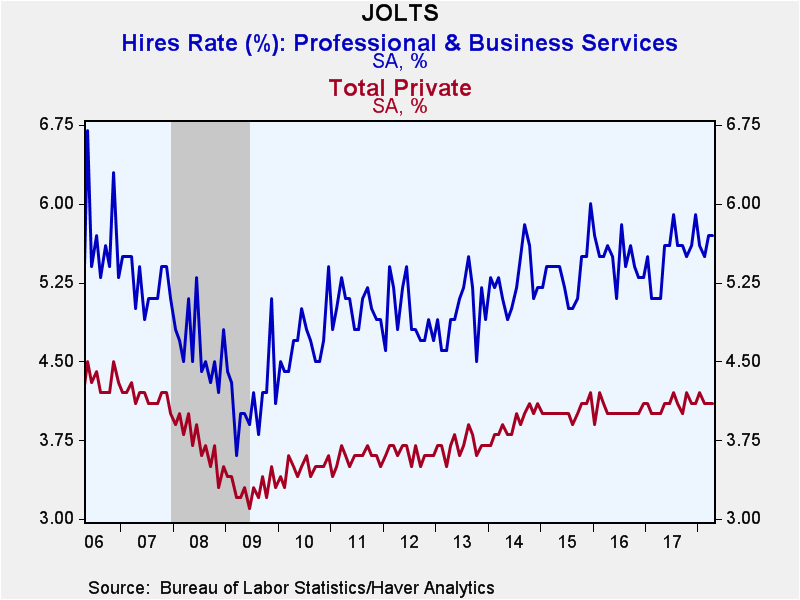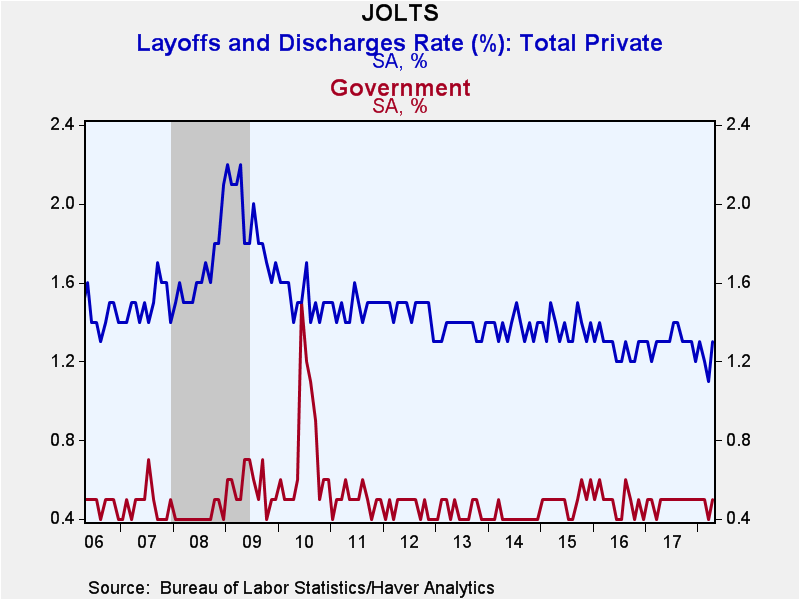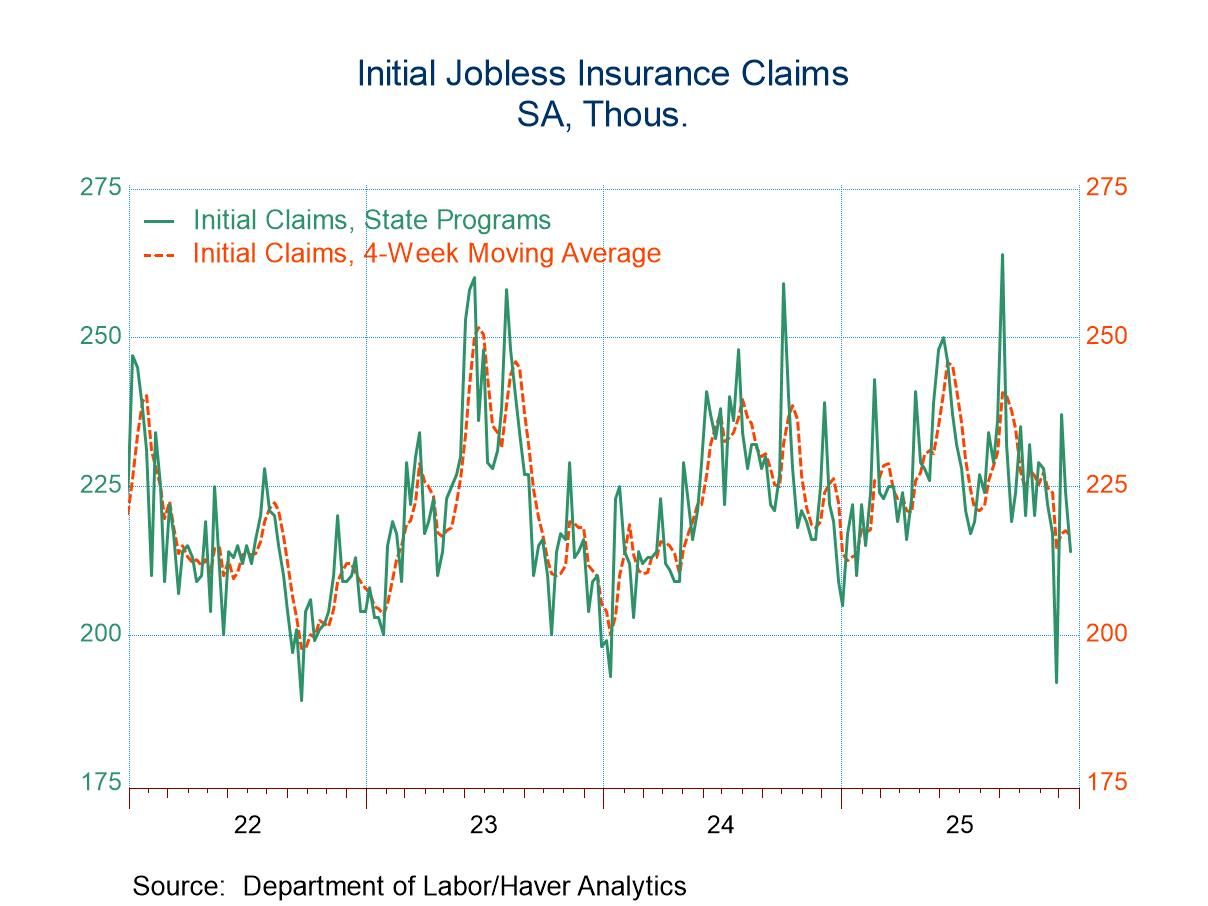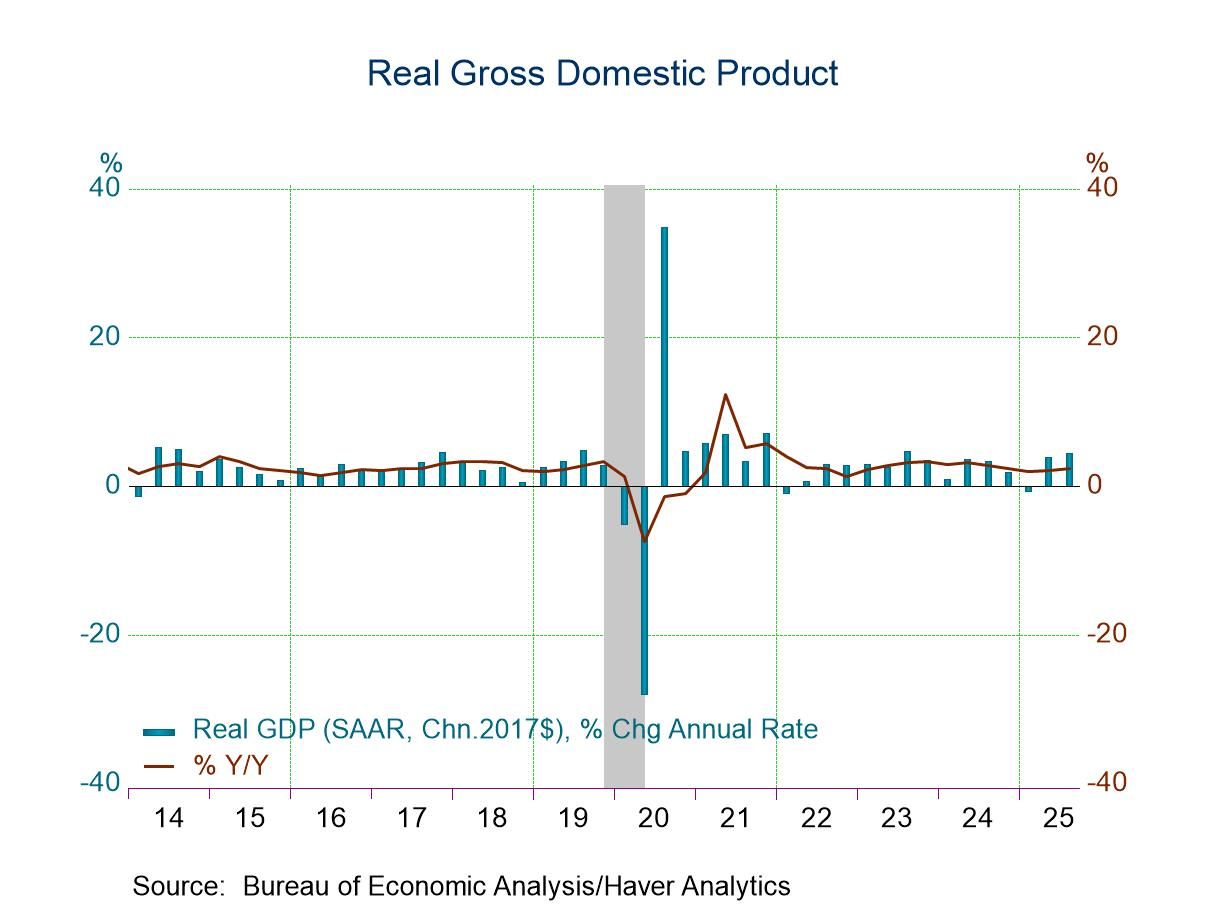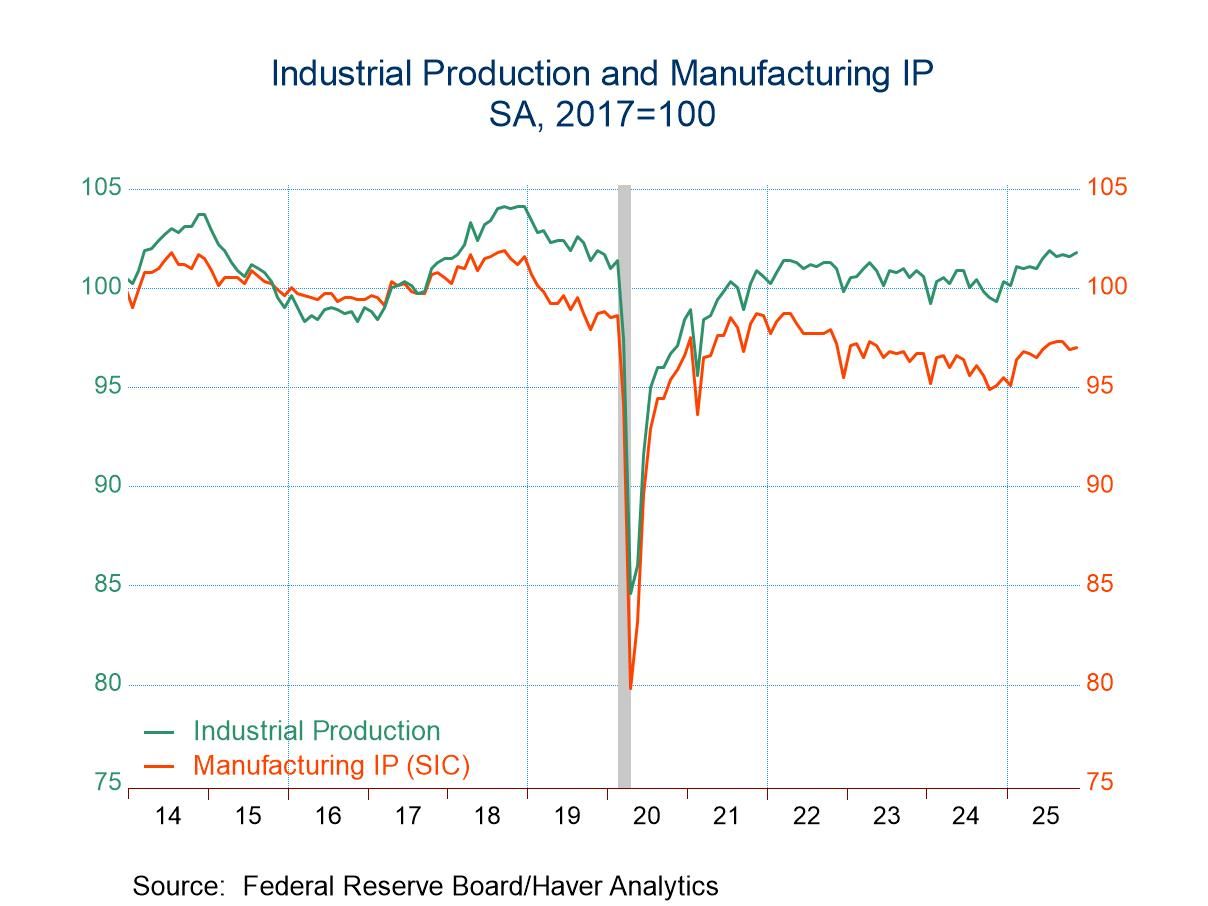 Global| Jun 05 2018
Global| Jun 05 2018U.S. JOLTS: Job Openings Rate Holds Steady; Hires Rate Improves
by:Tom Moeller
|in:Economy in Brief
Summary
The Bureau of Labor Statistics reported that the total job openings rate during April was unchanged at 4.3%, but was higher than the 4.0% rate twelve months earlier. (The job openings rate is the job openings level as a percent of [...]
The Bureau of Labor Statistics reported that the total job openings rate during April was unchanged at 4.3%, but was higher than the 4.0% rate twelve months earlier. (The job openings rate is the job openings level as a percent of total employment plus the job openings level.) The hiring rate rose to 3.8% and equaled the highest level since October 2007.
The private-sector job openings rate held steady at the expansion high of 4.6%, and March was revised up from 4.5%. The rate rose in professional & business services (5.7%), leisure & hospitality (5.5%) and education & health services (5.1%). The job openings rate in trade, transportation and utilities held steady at 4.3%, and in the manufacturing sector the job openings rate improved to 3.4%. In construction, the rate eased to 3.1%. The job openings rate in the government sector slipped to 2.5%.
The level of job openings increased 1.0% (9.7% y/y) after surging 9.1% in March. Private-sector openings improved 1.5% (9.9% y/y) to 6.117 million. Job opening increased 21.0% y/y in trade, transportation & utilities. Professional & business services job openings gained 22.9% y/y while leisure & hospitality openings rose 11.0% y/y. Openings in education & health services increased 9.1% y/y and factory sector openings increased 20.9% y/y. To the downside, openings in construction eased 0.4% y/y. Openings in government improved 6.8% y/y.
The private-sector hiring rate held steady at 4.1%, where it's been for five of the last six months. The rate in leisure & hospitality (6.4%), professional and business services (5.7%) and trade, transportation & utilities (4.0%) remained firm. In construction, the rate rose to 4.9% and in education & health services, it improved to 2.9%. In the factory sector, the rate eased to 2.7%. The government sector hiring rate held steady at 1.5%, about where it's been since late 2016.
Total hiring increased 6.8% y/y. Hiring in the private sector also increased 6.8% y/y led by a 14.4% y/y gain in professional & business services jobs. Factory sector hiring rose 11.3% y/y, but construction sector employment declined 7.2% y/y. Leisure & hospitality hiring improved 4.2% y/y, while the number of education & health services workers improved 2.4% y/y. Hiring in the public sector increased 6.6% y/y.
The overall job separations rate was stable m/m to 3.6%, about where it's been since 2015. It held at 4.0% in the private sector and ticked up to 1.6% in government. The level of overall separations rose 5.8% y/y.
The level of layoffs increased 1.4% y/y, leaving the 1.2% layoff rate up from March's record low of 1.0%. In the private sector, the layoff rate rose to 1.3% and gained to 0.5% in the public sector.
The Job Openings & Labor Turnover Survey (JOLTS) survey dates to December 2000 and the figures are available in Haver's USECON database.
| JOLTS (Job Openings & Labor Turnover Survey, SA) | Apr | Mar | Feb | Apr'17 | Apr '16 | Apr'15 |
|---|---|---|---|---|---|---|
| Job Openings, Total | ||||||
| Rate (%) | 4.3 | 4.3 | 3.9 | 4.0 | 3.9 | 3.8 |
| Total (000s) | 6,698 | 6,633 | 6,078 | 6,108 | 5,893 | 5,625 |
| Hires, Total | ||||||
| Rate (%) | 3.8 | 3.7 | 3.7 | 3.6 | 3.6 | 3.6 |
| Total (000s) | 5,578 | 5,486 | 5,511 | 5,225 | 5,243 | 5,120 |
| Layoffs & Discharges, Total | ||||||
| Rate (%) | 1.2 | 1.0 | 1.1 | 1.2 | 1.2 | 1.3 |
| Total (000s) | 1,710 | 1,547 | 1,620 | 1,687 | 1,736 | 1,793 |
Tom Moeller
AuthorMore in Author Profile »Prior to joining Haver Analytics in 2000, Mr. Moeller worked as the Economist at Chancellor Capital Management from 1985 to 1999. There, he developed comprehensive economic forecasts and interpreted economic data for equity and fixed income portfolio managers. Also at Chancellor, Mr. Moeller worked as an equity analyst and was responsible for researching and rating companies in the economically sensitive automobile and housing industries for investment in Chancellor’s equity portfolio. Prior to joining Chancellor, Mr. Moeller was an Economist at Citibank from 1979 to 1984. He also analyzed pricing behavior in the metals industry for the Council on Wage and Price Stability in Washington, D.C. In 1999, Mr. Moeller received the award for most accurate forecast from the Forecasters' Club of New York. From 1990 to 1992 he was President of the New York Association for Business Economists. Mr. Moeller earned an M.B.A. in Finance from Fordham University, where he graduated in 1987. He holds a Bachelor of Arts in Economics from George Washington University.


